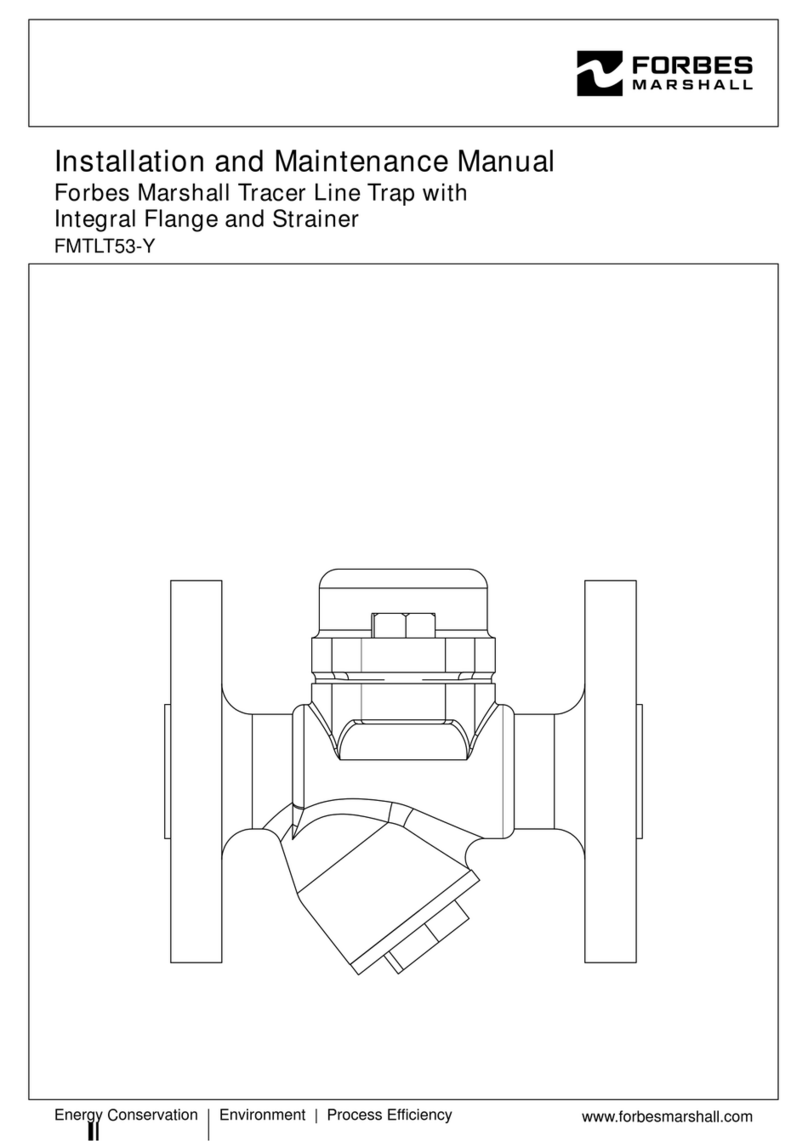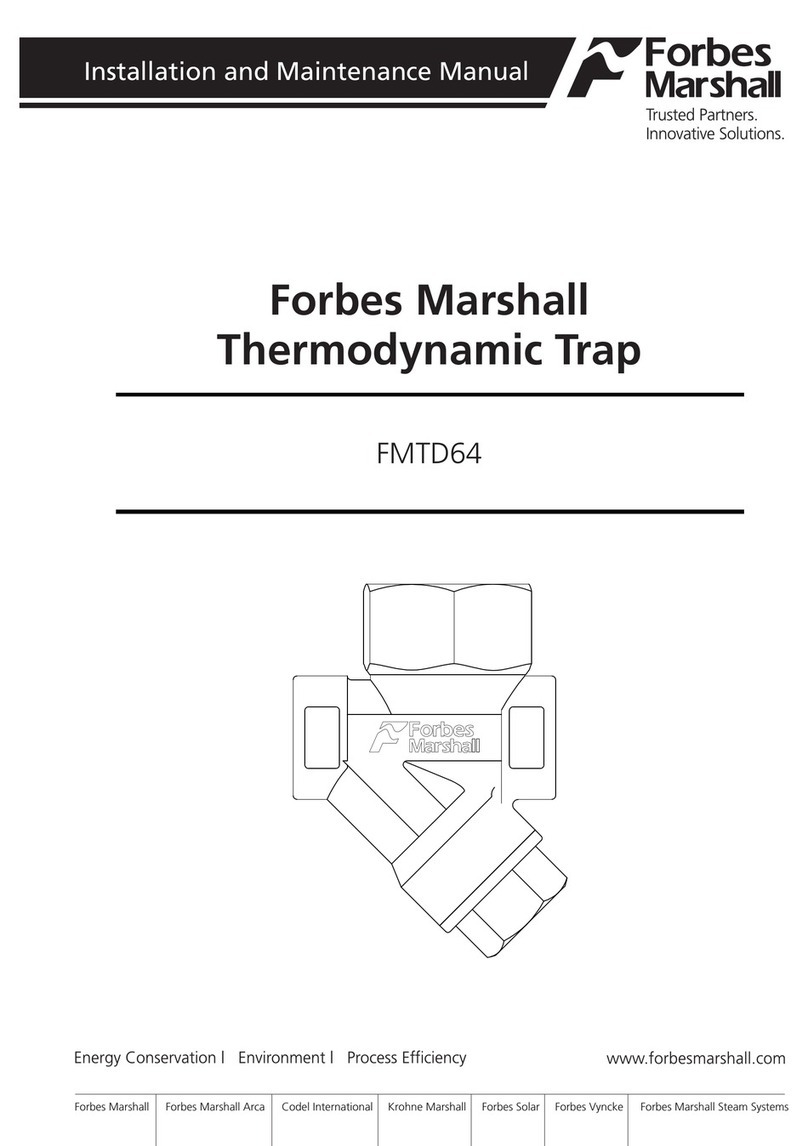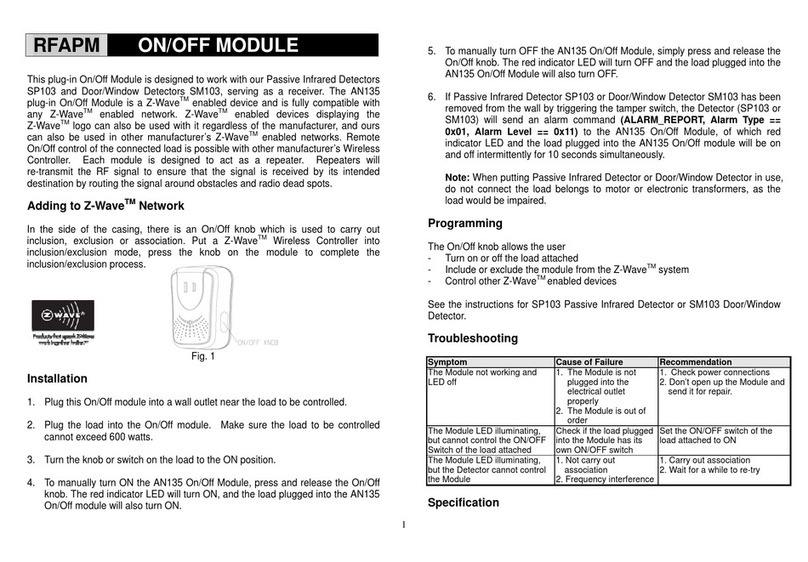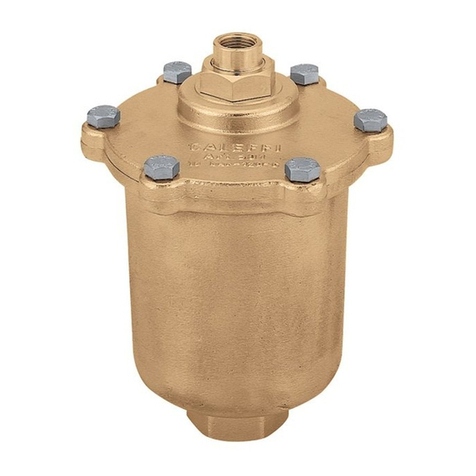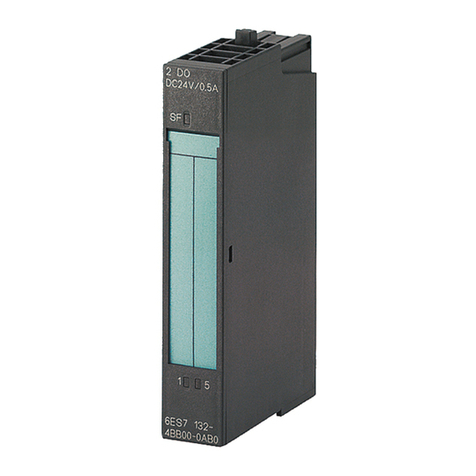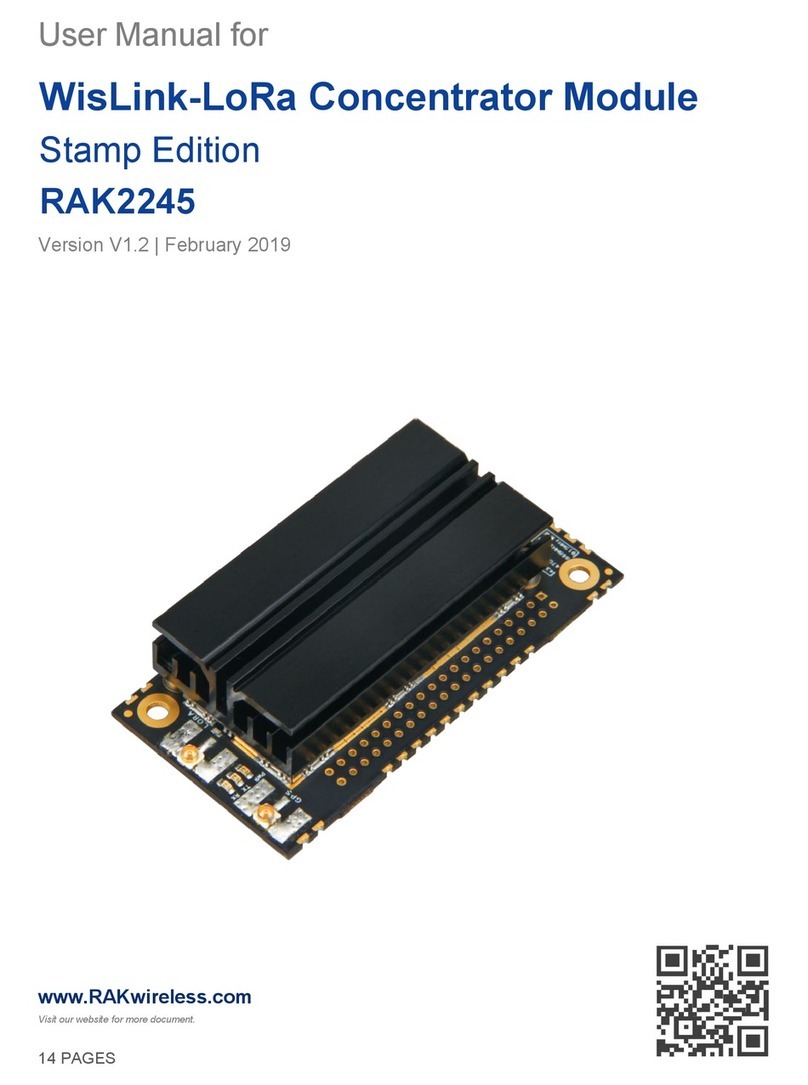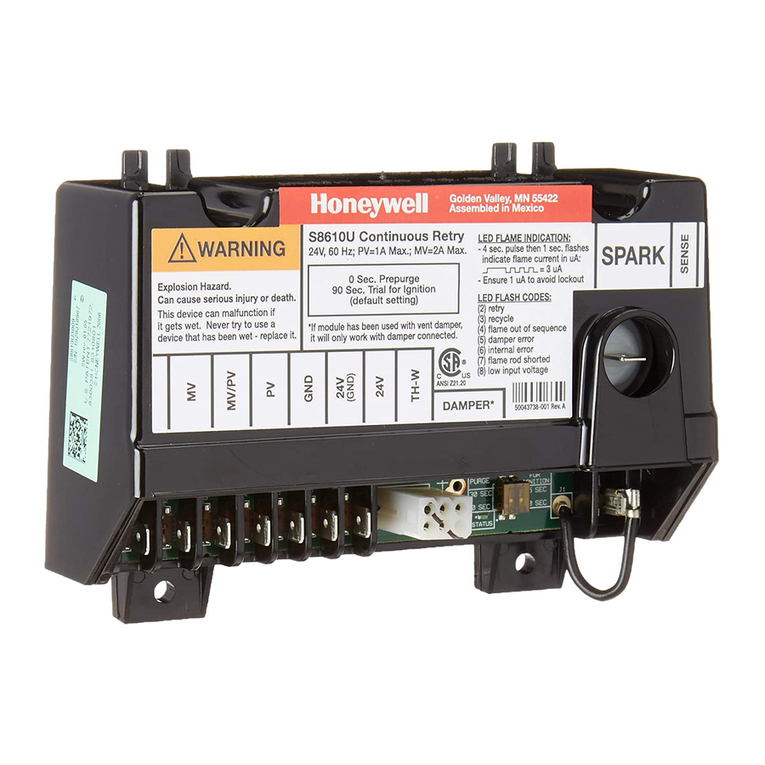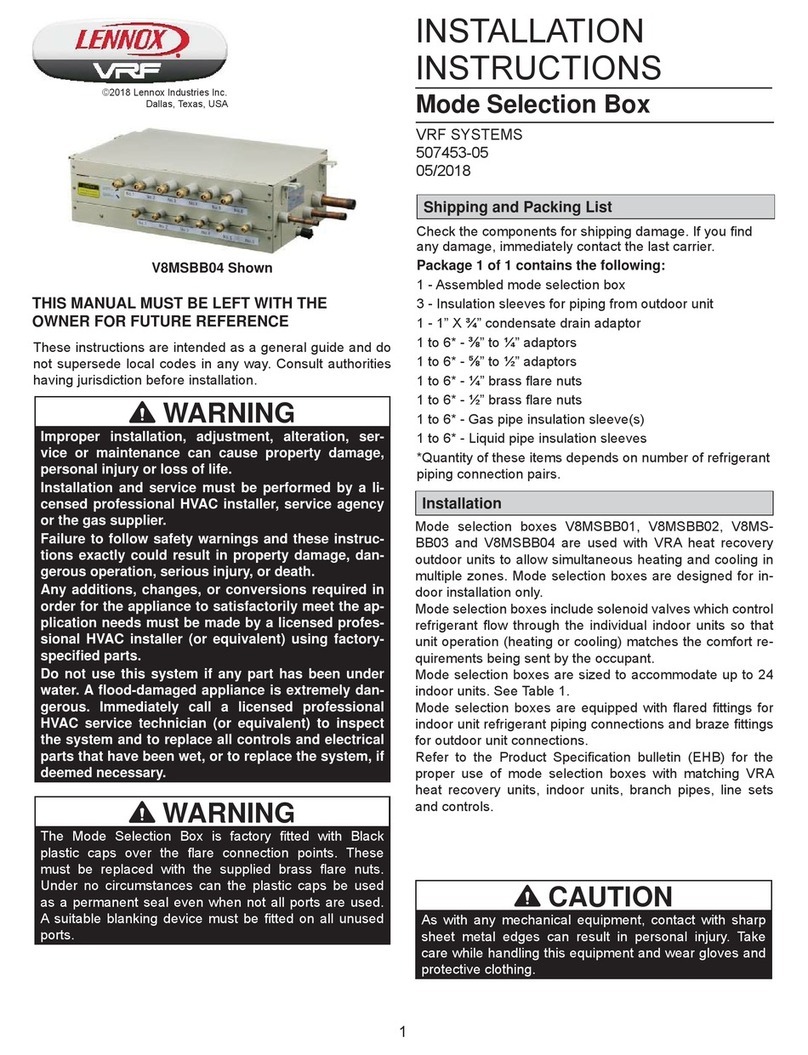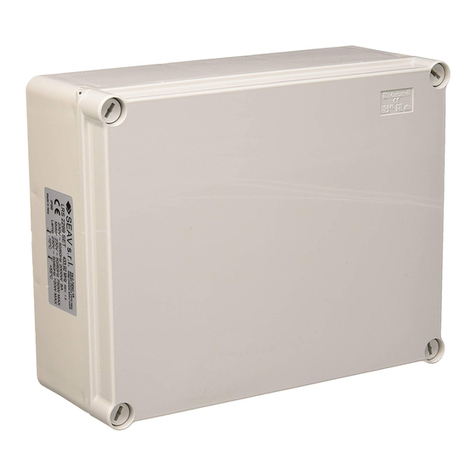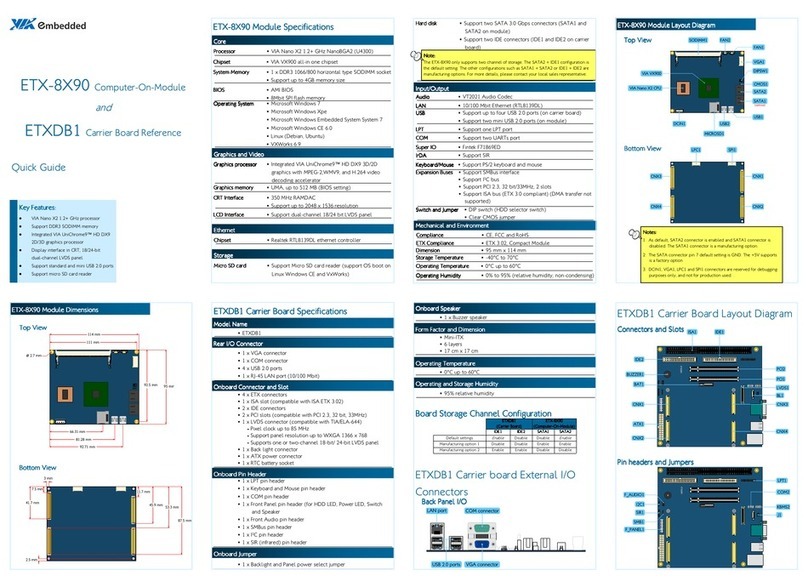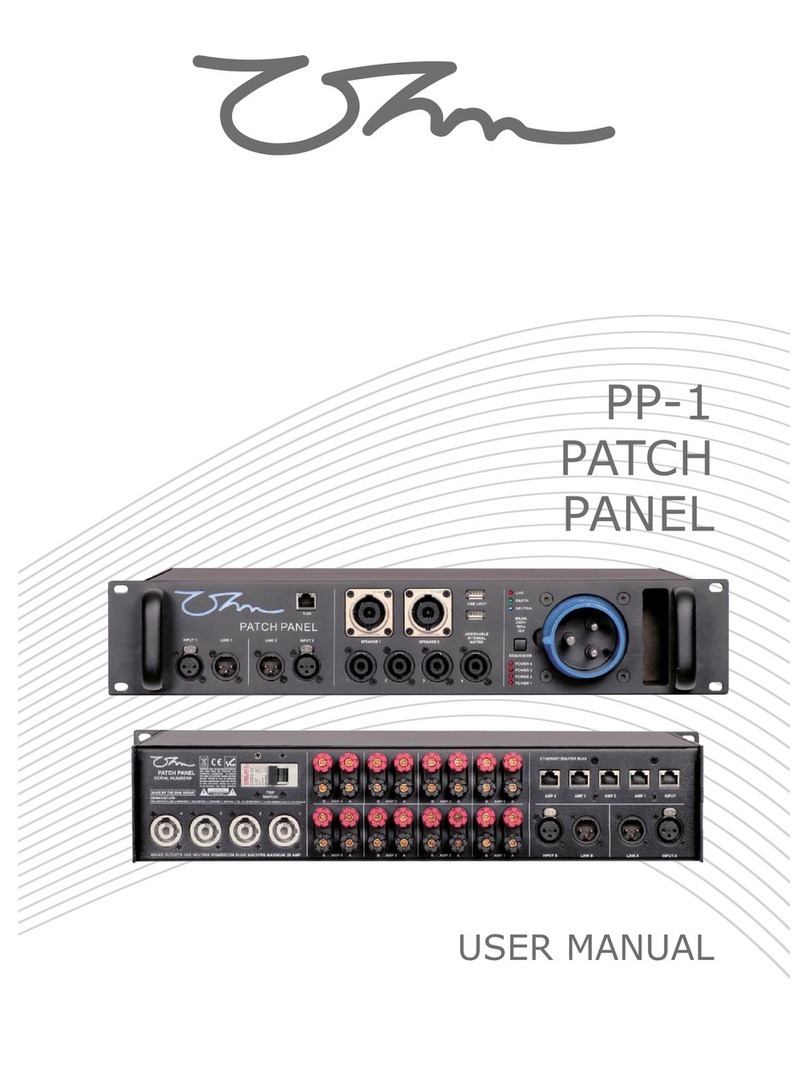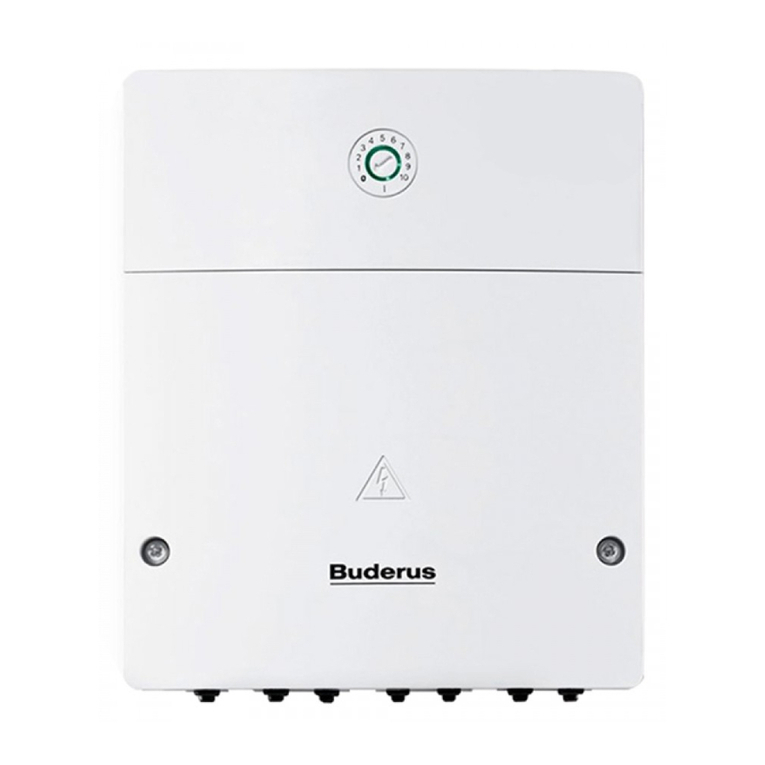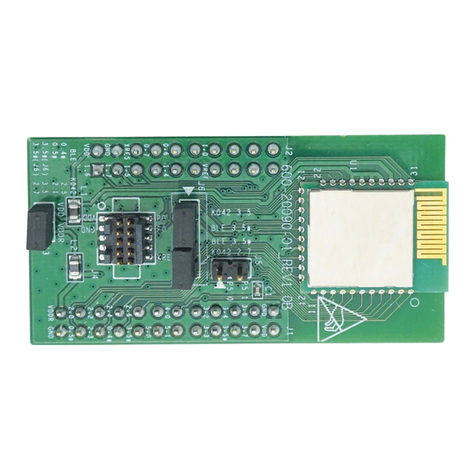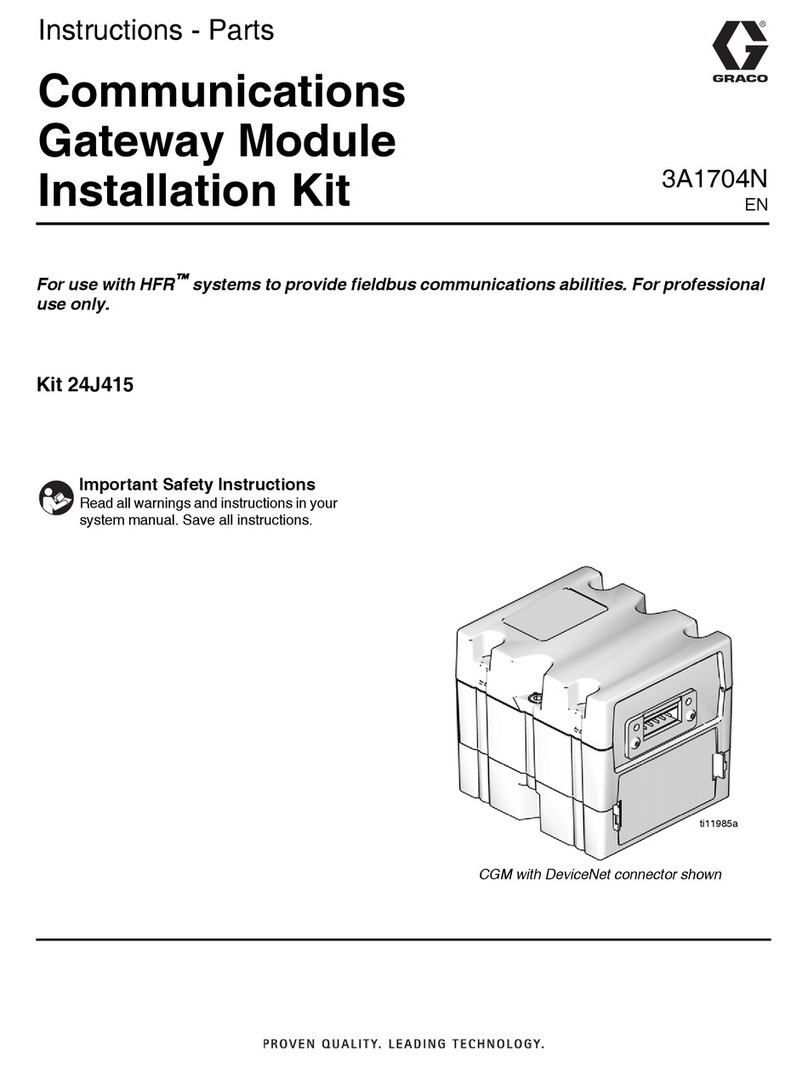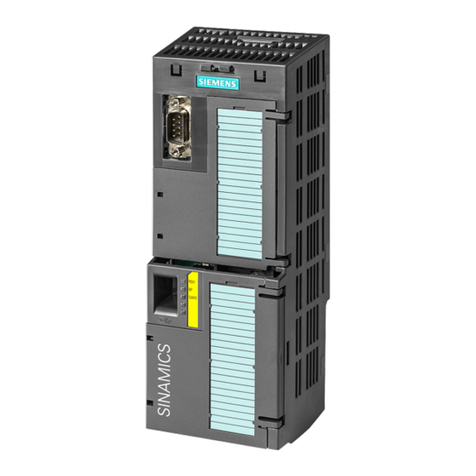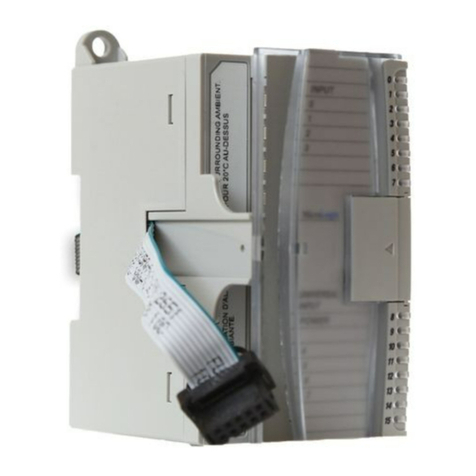Forbes Marshall FMPRV41 Manual

Forbes Marshall Pilot Operated Pressure
Reducing Valve
FMPRV41
Installation and Maintenance Manual
Energy Conservation | Environment | Process Efficiency www.forbesmarshall.com

1. Preface .................................................................................1
2. Important Safety Notes ........................................................1
3. Brief Product Information .....................................................3
4. Product Working Principle .....................................................9
5. Installation Guidelines ........................................................10
6. Startup and Commissioning.................................................15
7. Maintenance Guidelines ....................................................16
8. Troubleshooting ..................................................................28
9. Available Spares ................................................................31
10. Warranty Period .................................................................33
Table of Contents
PLEASE NOTE - Throughout this manual this cautionary symbol is used to
describe a potential damage or injury that might occur if the safety
considerations are overlooked. This symbol denotes CAUTION, WARNING or
DANGER.
Forbes Marshall Pilot Operated Pressure ReducingValve

1
1.
2.
Preface:
This manual is intended for anyone using, commissioning, servicing, or disposing the below
mentionedproductssafelyandefficiently.
ForbesMarshallPilotOperatedPressureReducingValve[FMPRV41]
Sizes: DN15(1/2“),DN20(3/4”),DN25(1”),DN40(1¾”)andDN50(2”)
PLEASENOTE:
Throughout this manual the following cautionary symbol is used to describe a potential damage
orinjurythatmightoccurifthesafetyconsiderationsareoverlooked.
ImportantSafetyNotes:
Read this section carefully before installing/operating/maintaining the product. The
precautions listed in this manual are provided for personnel and equipment safety.
Furthermore, Forbes Marshall accepts no responsibility for accidents or damage
occurring as a result of failure to observe these precautions. Note that the product is
designedtoperformfornon-contaminatedfluidsonly.Acontaminationintheformof
chemical,foreignparticleetc.canleadtoproblemwithproductperformanceandlifeof
theproduct.
If these products in compliance with the operating instructions are, properly installed,
commissioned, maintained and installed by qualified personnel (refer Section 2.7) the safety
operationsoftheseproductscan be guaranteed. General instructions for properuseoftoolsand
safetyofequipments,pipelineandplantconstructionmustalsobecompliedwith.
2.1 Intendeduse:
Check if the product is suitable for intended use/ application by referring to the installation
andmaintenanceinstructions,nameplatesandtechnicalinformationsheets.
i) Theproductissuitableforuse asdefinedin thetechnicalinformation sheet.Incase the
need arises to use the product on any other fluid please contact Forbes Marshall for
assistance.
ii) Checkforthesuitabilityinconformancetothelimitingconditionsspecifiedintechnical
informationsheetoftheproduct.
iii) Thecorrectinstallationanddirectionoffluidflowhastobedetermined.
iv) Forbes Marshall products are not intended to resist external stresses, hence necessary
precautionstobetakentominimizethesame.
2.2 AccessibilityandLighting:
Safeaccessibilityandworkingconditionsaretobeensuredpriortoworkingontheproduct.
FMPRV41

2
2.3 Hazardousenvironmentandmedia:
The product has to be protected from hazardous environment and check to ensure that no
hazardousliquidsorgasespassthroughtheproduct.
2.4 Depressurizingofsystemsandnormalizingoftemperature:
Ensure isolation and safety venting of any pressure to the atmospheric pressure. Even if the
pressure gauge indicates zero, do not make an assumption that the system has been
depressurized.
Toavoiddangerofburnsallowtemperaturetonormalizeafterisolation.
2.5 Toolsandconsumables:
Ensure you have appropriate tools and / or consumables available before starting the work.
UseoforiginalForbesMarshallreplacementpartsisrecommended.
2.6 Protectiveclothing:
Consider for the requirement of any protective clothing for you/ or others in the vicinity for
protection against hazards of temperature (high or low), chemicals, radiation, dangers to
eyesandface,noiseandfallingobjects.
2.7 Permitstowork:
All work to be carried out under supervision of a competent person. Training should be
imparted to operating personnel on correct usage of product as per Installation and
Maintenance instruction. “Permit to work” to be complied with (wherever applicable), in
case of absence of this system a responsible person should have complete information and
knowledgeon whatwork isgoingonandwhererequired,arrangetohaveanassistantwith
his primary goal and responsibility being safety. “Warning Notices” should be posted
wherevernecessary.
2.8 Handling:
There is a risk of injury if heavy products are handled manually. Analyze the risk and use
appropriatehandling method by taking into consideration the task, individual, the working
environmentandtheload.
2.9 Freezing:
Provision should be made to protect systems which are not self-draining, against frost
damage(inenvironmentwheretheymaybe exposedtotemperaturesbelowfreezingpoint)
tobemade.
2.10 Returningproducts:
CustomersandStockistareremindedthat,whenreturningproductstoForbesMarshallthey
must provide information on any hazards and the precautions to be taken due to
contamination residues or mechanical damage which may present a health, safety or
environmentalrisk.
This information must be provided in writing including Health and Safety data sheets
relatingtoanysubstancesidentifiedashazardousorpotentiallyhazardous.
Forbes Marshall Pilot Operated Pressure ReducingValve

3
FMPRV41
PMO-Maximum allowable pressure 17 bar g
TMO-Maximum allowable temperature 232°C
Cold hydraulic test pressure 34 bar g
Spring range 0.3 to 17 bar g
3. Brief Product Information:
3.1 Description:
TheForbesMarshallPilotOperatedForbesMarshallPilotOperatedPressureReducingValve,
FMPRV41isaSGironpilotoperatedForbesMarshallPilotOperatedPressureReducingValve
suitableforsteamorcompressedair.
3.2 Sizes and End Connections:
DN 15, 20, 25, 40 and 50
Screwed: BSPT / NPT for DN 15, 20, 25
Flanged: BS 10 table “F/H” for DN 40 and 50
DN15 FMPRV41 LC versions available
3.3 Limiting Conditions:
3.4 Pressure Sensing Pipe:
The FMPRV41 controls the pressure by sensing the downstream pressure through a
pressure sending pipe taken to the union (item L ) or through the internal sensing pipe
(item M). Fitting of the external pressure sensing pipe is described in the user manual
supplied with the valve.Note: Capacity is reduced and there is a possibility of hunting if
an external pressure sensing pipe is not fitted.
3.5 Operating Range:
KV Values
The Kv values are full capacities and should be used for safety valve sizing purpose
only
SIZE DN15 DN20 DN25 DN40 DN50
KV 2.8 5.5 8.1 17 28
For conversion Cv (UK)=Kv x 0.963
Cv (US)=Kv x 1.156
The product must not be used in this region.
Pressure bar g
Temperature °C
A
E
Steam
saturation
curve
C
F
BD
G
0515 20
10 17
100
150
50
200
232

4Forbes Marshall Pilot Operated Pressure ReducingValve
Figure 1: Forbes Marshall Pilot Oprated Presure Reducing valve - FMPRV41 steam.

5
FMPRV41
No Part Material Standard
1 Adjustments screw Carbon Steel IS1367Gr14
2 Adjustment lock nut SS Type 304
3 Spring housing SG iron EN-JS1025 DIN EN 1563
4 Top spring pad C-20 IS2062
5 Pressure adjustment Spring SS Type 302 IS4454 Part IV Gr.1
6 Bottom spring pad SS Type 304 ASTM A276
7 Spring housing
Securing nut Carbon Steel HT IS 1367
Securing studs Carbon Steel HT IS 1367
DN 15-32 M10x95mm
DN 40, 50 M12x95mm
8 Pilot diaphragms SS Type 304 ASTM A240
9 Pilot valve chamber SG iron EN-JS1025 DIN EN1563
10 Pilot valve plunger SS Type 304
11 Pilot valve seat with SS BS 970 431 S29
integral seal +PTFE
12 Pilot valve ball SS AISI 420
13 Pilot valve Spring SS BS 2057 302 S26
14 Pilot Valve clip SS ASTM A240 Type 301
15 Pilot filter cap gasket SS BS 1449-304-S16
16 Pilot filter cap SS ASTM A743Gr. CA 40
17 Pilot filter element Bronze
18 Internal strainer SS ASTM A240 Type 304
19 Body gasket SS forced
exfoliated graphite
20 Main valve return spring Stainless Steel BS 2056 302 S26
21 Main valve Stainless Steel ASTM A276 Type 420
22 Main valve seat Stainless Steel ASTM A276 Type 420
23 Balance pipe assembly Stainless Steel ASTM A213 Type 304
24 Main Valve body SG iron EN JS1025 DIN EN 1563
25 Lower diaphragm chamber SG iron EN-JS1025 DIN EN 163
26 Lower diaphragm chamber
Securing nuts Carbon steel S1367
Securing Bolts Carbon steel S 1367
DN 15 - 25 M12x50mm
DN 40, 50 M12x50mm
27 Main diaphragm pad SS Type 304 ASTM A240
28 Lower diaphragm pad SS Type 304 ASTM A276
29 Pushrod SS Type 431
30 Lock nut SS Type 316
31 Control pipe assembly SS Type 304 ASTM A213
32 Name plate SS
Materials:

6Forbes Marshall Pilot Operated Pressure ReducingValve
3.6 Product Dimension and Drawing:
Dimensions (approx.) in mm
Size Screwed A Flanged A1 B D E
DN15 160 ..... 181 410 130
DN15 LC 160 ..... 181 410 130
DN20 160 ..... 181 410 130
DN25 180 ..... 203 430 144
DN40 ..... 212 251 450 149
DN50 ..... 232 251 480 174
FMPRV41 (Steam)
FMPRV41 STEAM
M
FMPRV41 AIR
Size Screwed A Flanged A1 B D E
15 160 ..... 181 360 130
DN15 LC 160 ..... 181 360 130
DN20 160 ..... 181 360 130
DN25 180 ..... 203 383 144
DN40 ..... 212 251 415 149
DN50 ..... 232 251 415 174
DN
FMPRV41 (Air)
Figure 2: Dimensional drawing of FMPRV41-STEAM
Figure 3: Dimensional drawing of FMPRV41-Air

3.6 Steam Capacity Chart:
Note
The capacities quoted below are based on valves fitted with an external pressure
sensing pipe. Reliance on the internal pressure sensing pipe will mean that
capacities may be reduced. In the case of low downstream pressure this reduction
couldbeupto30%ofthevalvecapacity.
3.6.1 How to Use the Chart (for steam application):
Saturated Steam
Avalveisrequiredtopass600kg/hreducingfrom6bargto4barg.Findthepoint
at which the curved 6 bar g upstream pressure line crosses the horizontal 4 bar g
downstream pressure line. A perpendicular dropped from this point gives the
capacitiesofallFMPRV41sizesundertheseconditions.
Superheated steam
Because of the higher specific volume of superheated steam a correction factor
must be applied to the figure obtained from the chart above. For 55°C of
superheatthefactoris0.95andfor100°Cofsuperheatthefactoris0.9.
Using the example given for saturated steam, the DN40 valve would pass
1150X0.95=1092kg/hr. if the steam had 55°C superheat. It is still big enough to
passtherequiredloadof600kg/hr.
Upstream pressure bar g
Figure 4: FMPRV 41 Sizing (Steam application)
7
FMPRV41

3.6.2. How to Use the Chart: (for air application)
3
Capacities are given in cubic decimeters of free air per second (dm /s). The use of
thecapacitychartcanbebestexplainedbyanexample.
3
Required,avalvetopass100dm /soffreeairreducingfrom12bargto8barg.
Find the point at which the curved 12 bar g upstream pressure line crosses the
horizontal 8 bar g downstream pressure line. A perpendicular dropped
3
fromthis point shows that, a DN15 valve will pass approximately 120 dm /s under these
conditionsandisthecorrectvalvesizetochoose.
KV Values
The Kv values are full capacities and should be used for safety valve
sizing purpose only.
SIZE DN15 DN20 DN25 DN40 DN50
KV 2.8 5.5 8.1 17 28
For conversion Cv (UK)=Kv x 0.963
Cv (US)=Kv x 1.156
Compressed Air Capacity Chart
Upstream pressure bar g
Downstream pressure bar g
Figure 5: FMPRV 41 Sizing (air application)
8Forbes Marshall Pilot Operated Pressure ReducingValve

4. ProductWorkingPrinciple:[RefertoFigure1]
A Forbes Marshall Pilot Operated Pressure Reducing Valve balances the downstream pressure
throughthe pressuresensing pipe (23) against the pressureadjustmentcontrolspring (5). This in
turn moves the pilot valve plunger (10) in the pilot valve assembly (10, 11, 12, 13 and 14), to
modulate a control pressure which is directly proportional to the pilot valve opening. This control
pressure is transmitted to the underside of the main diaphragm (27) through the control pipe
(31). This movement in the diaphragm (27) pushes the pushrod (29) up and the main valve (21)
opensinproportiontothepilotvalveopening.
Understable loadconditions,thepressureunderneaththepilotdiaphragm (8)balancestheforce
whichisset on theadjustmentspring (5). Thissettlesthepilot valve, allowingaconstant pressure
working under the main diaphragm (27). This makes sure that the main valve (21) is also settled,
hencegivingastabledownstreampressure.
When downstream pressure rises, the pressure under the pilot diaphragm (8) becomes greater
thantheforcecreatedbythepressureadjustmentspring(5)andthismakespilotdiaphragm(8)to
move upwards. This closes the pilot valve seat (11) and will interrupt the transmission of steam
pressure underneath the main diaphragm (27). The top of the main diaphragm (27) is always
subjectedto downstreampressureatallthe timesand, asthereis morepressureabovethe main
diaphragm (27) than below, the main diaphragm (27) moves down pushing the steam
underneath it into the downstream outlet through the control pipe (31) and surplus pressure
orifice. The pressure on either side of the main diaphragm (27) is balanced, and a small excess
forcecreatedbythemainvalvereturnspring(20)closesthemainvalveseat(22).
Anyvariationinloadorpressurewillimmediatelybesensedonthepilotdiaphragm(8),whichwill
acttoadjustthepositionofthemainvalveaccordingly,ensuringaconstantdownstreampressure.
9
FMPRV41

5. InstallationGuidelines:
Note: Before implementing any installations observe the 'Important Safety notes” in
section 2. Referring to the Installation and Maintenance Instructions, name-plate and
Technical Information Sheet, check that the product is suitable for the intended
installation.
5.1 Fitting:
Thevalve shouldalwaysbefittedinahorizontal pipelinewith themaindiaphragmchamber
belowtheline(figure7). Tomeetthehighcapacitiesorwidelyvaryingloadsorwherestand-
byfacilityis required,twoormorevalvesmay beusedinparallel (figure6). For pressureturn
downinexcessof 10 to 1considerationshouldbegiven to using thetwovalvesin series. To
avoid turbulence between the two pressure reducing valves, the distance must be
equivalenttoatleast50 pipe diameters.To ensureadequatedrainage of the spacebetween
thetwopressurereducingvalvesatrapsetshouldbefittedasshowninfigure8.
Figure 6: Recommended installation of FMPRV41
*This is a typical representation of Forbes Marshall Pilot Operated Pressure Reducing Valve
10 Forbes Marshall Pilot Operated Pressure ReducingValve

11
FMPRV41
Fig. 7: Installation of Two FMPRV41 in parallel
*This is a typical representation of Forbes Marshall Pilot Operated Pressure Reducing Valve
Figure 8: Installation of Two FMPRV41 in series
*This is a typical representation of Forbes Marshall Pilot Operated Pressure Reducing Valve

12 Forbes Marshall Pilot Operated Pressure ReducingValve
5.2 Pipelinesizing:
The piping on both sides of the valve must be sized so that velocities do not exceed 30 m/s.
normally,acorrectlysizedFMPRV41willbesmallerthantheconnectingpipework.
5.3 Pipelinestresses:
Line stresses caused by expansion or inadequate support should not be imposed on the
valvebody.
5.4 IsolatingValves:
Theseshouldpreferablybeofthefullboretype.
5.5 Removalofcondensate:
Ensure that the pipework is supplied with dry steam. The ideal arrangement is to fit a
separator in the steam supply. If the steam is known to be dry then a drain pocket may be
adequate. If there is a rise in the low pressure line after the valve then a further drain point
shouldbeprovidedtokeepthevalvedrainedaftershutdown.
5.6 PreventingDirt:
The valve should be protected from dirt / foreign particles using pipeline strainer. The
strainershouldbefittedonitssidetopreventtheaccumulationofwater.
5.7 PressureControlPipe:
For applications that require closer control, improved stability or maximum capacity
conditiontheinternal balance pipeshouldbereplacedby an external pressuresensing pipe
(suppliedbyothers)asfollows:
Sr. No. DESCRIPTION
1 Interconnecting Pipework for Pressure Reducing Station
2 Stop Valve (Inlet)
3 Stop Valve (Bypass)
4Strainer
5 Forbes Marshall Pilot Operated Pressure Reducing Valve, FMPRV41
6Stop Valve (Outlet)
7 Safety Valve
8 Stop Valve ( Pressure Balancing Line)
9 Moisture Separator
10 Drain Trap Assembly
11 Dial Pressure Gauge (Inlet)
12 Dial Pressure Gauge (Outlet)
13 Stop Valve (Dial Pressure Gauge)

13
FMPRV41
Removetheinternalbalancepipeassembly.Theresulting1/8''BSPtappinginthesideofthe
body should be blanked using a plug provided in the bag attached to the valve. The other
1/4'' BSP tapping in the side of the pilot valve chamber should be used to fit the external
pressure sensing pipe. This is suitable for the fitting of 13.7mm O/D pipe. If suitable pipe is
not available the compression fitting can be removed and 1/4'' nominal bore steel pipe
screwed directly to the pilot valve chamber. The pressure control pipe should be connected
in to the top of the reduced pressure main at a point where in either direction there is a
length of straight pipe uninterrupted by fittings for at least 1mor 15 pipe diameters
whichever is the greater. It should be arranged with a positive fall so that any condensate
can drain away from the FMPRV41.Where the size of the reduced pressure main makes it
difficultto maintain a fall when entering the top of the main, the pressurecontrol pipe may
beconnectedinthesideofthemain.
5.8 Pressuregauges:
Itisessentialtofitapressuregaugeonthedownstreamsidesothatthevalvecanbeproperly
set.Apressuregaugeontheupstreamsidecanalsobeuseful.
5.9 ContinuousDuty:
For continuous duty applications where a constant steam supply is essential then a parallel
stand- by pressure reducing valve station is recommended to allow for planned
maintenanceseefig6.Alternativelyaby-passlinecanbeused(seefig7).Itisimportantthat
the by-pass should have a similar capacity to the Forbes Marshall Pilot Operated Pressure
Reducing Valve which is achieved by choosing an appropriately sized valve or by using a
reducedorificeintheline.
Thehand wheelshouldbe padlockedtopreventunauthoriseduse,andwhenin useshould
beunderconstantmanualsupervision.
Theby-passmaybearrangedaboveortothesideofthemainassemblybutneverbelowit.
5.10 Safetyvalve:
A safety valve should be fitted to protect the down steam equipment from excessive
pressure. It should be set to lift below the safe working pressure of the downstream
equipmentandwillnormallybesizedtopassthefullcapacityofthepressurereducingvalve.
The safety valve set pressure should take account of its re seat characteristics and the 'No-
load' pressure setting of the pressure reducing valve. For example, the typical blowdown
value (re seat differential) for a DIN type safety valve is 10% of the set pressure. The
minimum possible safety valve set pressure must there for equal the no-load set pressure of
thereducingvalveplustheblowdownvalueofthesafetyvalveplusasmallmarginofatleast
0.1bar.Ifthesafety valvelifts andtheworkingpressureis tooclosethenitwillnotbe ableto
closeproperlyandwillsimmer,createaleakwhichisoftenwronglydiagnosedasaresultofa
leakingreducingvalve.
Dischargepipeworkshouldbetakentoasafeplace.

14 Forbes Marshall Pilot Operated Pressure ReducingValve
5.11 Positioninrelationtoothercontrolvalves
Figure 9: FMPRV41 position in relation to other control equipment
*This is a typical representation of FMPRV41 position in relation to other control
equipment.
Line or system stop valves, either remotely actuated or manually, should be installed on the
upstreamsideoftheForbesMarshallPilotOperatedPressureReducingValveFMPRV41.
Where there is downstream control equipment, particularly temperature control valve,
ensure the control equipment is atleast 50 pipe diameters away from the FMPRV41 to
prevent pressure pulses being transmitted back causing unstable operation and premature
wearorifthisisimpracticalanintermediatevesselcanprovideasimilarbenefit.
Where a safety valve is required to protect the process system downstream of a FMPRV41
andwhereatemperaturecontrolvalve isalso beinguseddownstreamoftheFMPRV41, itis
recommended that the safety valve is fitted downstream of the temperature control valve
rather than in between the FMPRV41 and the temperature control valve. If any slight
leakage occurs this will avoid any pressure build-up causing nuisance operation of the
safetyvalvebutprovidecompleteprotectionforthedownstreamsystem.
Where valves are installed downstream of the FMPRV41 the intermediate downstream
pipework must be properly trapped to ensure no condensate can build up on the
downstreamsideoftheFMPRV41.

15
FMPRV41
6. StartupandCommissioning:(Referfigure7)
1. Ensure that all connections are properly made and that all stop valves (2, 3 and 6) are
closed.
2. Closeallstopvalve(2,3and6)atreducingvalvestation,includingvalvesonbypassline
iffitted.
3. Check that adjustment screw of the Forbes Marshall Pilot Operated Pressure Reducing
Valve,FMPRV41(5)isturnedfullyanti-closewiseuntilspringisslack.
4. Checkthatthepressuregaugeisolatingvalve(13)areopen.
5. For correct operation of the FMPRV41 (5) it is important that the pilot and main valves
are not subjected to dirt or other hard particles .Therefore, prior to bringing the
FMPRV41(5)intooperationensurethattheupstreampipeworkhasbeenclearedofall
the loose dirt and hard particles and that the main strainer screen (4) is examined and
cleanedifnecessary.
6. Slowlyopentheupstreamstopvalve(2)untilitisfullyopen.
7 Using a suitable sized spanner slowly turn adjustment screw of FMPRV41 (5) in a
clockwisedirectionuntildesireddownstreampressurereadingisobtained.
8. Holding the adjustment screw of FMPRV41 (5) in position with the spanner tighten
downthelock-nuttosecurethesettingoftheadjustmentspring.
9. Slowlyopenthedownstreamstopvalve(6)untilitisfullyopen.
Note:Afterinstallationormaintenanceensurethatthesystemisfullyfunctional.Carry
out tests on any alarms or protective devices. It is recommended that after
commissioning the pilot filter is changed and the spare one (supplied with the valve) is
fitted.

16 Forbes Marshall Pilot Operated Pressure ReducingValve
7. MaintenanceGuidelines:
Before undertaking any maintenance on the product it must be isolated from both
supply line and return line and any pressure should be allowed to safely normalize to
atmosphere. The body gasket (all FMPRV41derivatives) and actuating chamber gasket
contains a thin stainless steel support ring which may cause physical injury if not
handledanddisposedofcorrectly.
7.1 RoutineandPreventiveMaintenance:
Please refer to the maintenance schedule mentioned in the table below to undertake
routinemaintenanceoftheFMPRV41.
SR. PARAMETERSTO BE CHECKED FREQUENCY FOR CHECKING VARIOUS PARAMETERS
AForbes Marshall Pilot Operated
Pressure Reducing Valve Daily Weekly Monthly Quarterly Half Yearly Annually.
1Clean Main valve strainer Y
2Clean Pilot valve chamber assembly kit Y
3Check & clean Main / Pilot diaphragm Y
4Clean SS tube & stud coupling with split pin Y
5Main valve cleaning Y
6FMPRV41 overhauling and push rod
checking Y
7PilotValve chamber Strainer Y

17
FMPRV41
7.2 ToolKit:
To carry out maintenance of the Forbes Marshall Pilot Operated Pressure Reducing Valve
FMPRV41referthetoolsmentionedinthetablebelow.
Size Component Tool used and Size
DN 15 / Main valve seat assembly Ring spanner 36 mm (A/F)
DN 15 Veriner to measure depth & lift of the push rod (main valve head &
seat assembly) 1.8 mm lift
DN 20 Veriner to measure depth and lift of the push rod (main valve head
and seat assembly) 2.3 mm lift
DN 25 Main valve seat assembly Ring spanner 41 mm (A/F)
Veriner to measure depth and lift of the push rod (main valve head
and seat assembly) 2.8 mm lift
DN 15 /
20 /25
Push rod lock nut Open spanner 13 mm (A/F)
Lower stud coupling Box spanner 13 mm (A/F)
Pilot valve assembly Ring spanner 19 mm (A/F)
M12 bolt and nut for bottom plate assembly Box spanner 19 mm (A/F)
Pilot Valve Chamber Assembly
M10 studs Stud Runner M10 X 1.5
Nut Ring spannar 17mm (A/F)
Split Pin Nose Plier
M10 bolt for housing and spring assembly Box Spanner 17 mm (A/F)
4 No control pipe (Elbow fitting ) Open Spanner 13mm (A/F)
Lower drain Open Spanner 10mm (A/F)
Strainer cap Box Spanner 19 mm (A/F)
DN 40 Main valve assembly (31mm slot and OD 37mm) Customer made tool has to be designed.
Veriner to measure depth and lift of the push rod (main valve head
and seat assembly) 4.5 mm lift
DN 50 Main valve assembly (42mm slot and OD 49 mm) Customer made tool has to be designed.
Veriner to measure depth and lift of the push rod (main valve head
and seat assembly) 4.8 mm lift
DN 40 /
50
Push rod lock nut Open spanner 17mm (A/F)
Stud coupling and long nut on lower plate Box spanner 13 mm (A/F)
M12 bolt and nut for bottom plate assembly Box spanner 19 mm (A/F)
Split Nut Nose Plier
Pilot Valve Chamber Assembly
M12 stud Stud Runner M12 X 1.75
Nut Ring spanner 24mm (A/F)
Strainer cap Box spanner 19 mm (A/F)
Pilot valve seat Open spanner 19mm (A/F)
M12 bolt for housing and spring Box spanner 19 mm (A/F)
4 No.control pipe (elbow fitting ) Open spanner 13 mm (A/F)
Low drain Open spanner 11mm (A/F)

18 Forbes Marshall Pilot Operated Pressure ReducingValve
7.3 Procedure torenewthepilotfilterelement: (RefertoFigure10)
1. Isolatethereducingvalveanddepressurizethesystemcompletely.
2. Unscrewthefiltercap(1)andcarefullywithdrawthefilterelement(2).
3. Replacetheelementandtightenthefiltercap.
Note:Thegasketisre-usable.
Figure 10: Filter element
7.4 Procedure toreneworchangethepressureadjustmentspring: (RefertoFigure11)
Isolate the reducing valve and completely depressurize the system in order to change the
pressureadjustmentspring.
1. Releasetheadjustmentlock-nut(2)byturningintheanticlockwisedirection.
2. Turn the adjustment screw (1) anticlockwise. Ensure there is no compression on the
pressureadjustmentspring(4).
3. Undo the 4 off spring housing securing nuts and bolts (3) and remove the spring
housing.
4. Removeandreplacethepressureadjustmentspring(4)andthetopspringplate(5).
Reassembleinreverseorder.
Figure 11: Pressure adjustment spring
1
Adjustment
Screw (1)
Adjustment
Locknut (2)
Spring Housing securing
Nuts and Bolts (3)
Top Spring Plate
(5)
Adjustment
Spring (4)
Filter
element
2
Filter cap
1
Table of contents
Other Forbes Marshall Control Unit manuals
